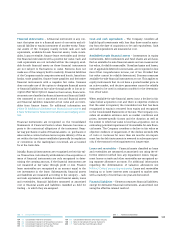Siemens 2011 Annual Report Download - page 265
Download and view the complete annual report
Please find page 265 of the 2011 Siemens annual report below. You can navigate through the pages in the report by either clicking on the pages listed below, or by using the keyword search tool below to find specific information within the annual report.
153 D. Consolidated Financial Statements 273 E. Additional information
158 D. Consolidated Statements of Changes in Equity
160 D. Notes to Consolidated Financial Statements
266 D. Supervisory Board and Managing Board
154 D. Consolidated Statements of Income
155 D. Consolidated Statements of Comprehensive Income
156 D. Consolidated Statements of Financial Position
157 D. Consolidated Statements of Cash Flow
sold on a stand-alone basis, (b) third-party prices for similar
components or, under certain circumstances, (c) cost plus an
adequate business-specific profit margin related to the rele-
vant element. By this means, reliable fair values are generally
available. However, there might be cases when fair value evi-
dence according to (a) and (b) is not available and the applica-
tion of the cost plus-method (c) does not create reasonable re-
sults because the costs incurred are not an appropriate base
for the determination of the fair value of an element. In such
cases the residual method is used, if fair value evidence is
available for the undelivered but not for one or more of the
delivered elements, i.e. the amount allocated to the delivered
elements equals the total arrangement consideration less the
aggregate fair value of the undelivered elements. If the three
separation criteria () to () are not met, revenue is deferred
until such criteria are met or until the period in which the last
undelivered element is delivered. The amount allocable to the
delivered elements is limited to the amount that is not contin-
gent upon delivery of additional elements or meeting other
specified performance obligations.
Interest income
Interests are recognized using the effective interest method.
Royalties
Royalties are recognized on an accrual basis in accordance
with the substance of the relevant agreement.
Income from lease arrangements
Operating lease income for equipment rentals is recognized
on a straight-line basis over the lease term. An arrangement
that is not in the legal form of a lease is accounted for as a
lease if it is dependent on the use of a specific asset or assets
and the arrangement conveys a right to use the asset. Receiv-
ables from finance leases, in which Siemens as lessor trans-
fers substantially all the risks and rewards incidental to own-
ership to the customer are recognized at an amount equal to
the net investment in the lease. Finance income is subse-
quently recognized based on a pattern reflecting a constant
periodic rate of return on the net investment using the effec-
tive interest method. A selling profit component on manufac-
turing leases is recognized based on the policies for outright
sales. Profit from sale and leaseback transactions is recog-
nized immediately if significant risks and rewards of owner-
ship have passed to the buyer, the leaseback results in an op-
erating lease and the transaction is established at fair value.
Dividends
Dividends are recognized when the right to receive payment
is established.
Functional costs – In general, operating expenses by types
are assigned to the functions following the functional area
of the corresponding profit and cost centers. Expenses relat-
ing to cross-functional initiatives or projects are assigned to
the
respective functional costs based on an appropriate
allocat ion
principle. For additional information on amortiza-
tion see Note 17 Other intangible assets, on depreciation see
Note 18 Property, plant and equipment and on employee
benefit expense see Note 35 Personnel costs.
Government grants – Government grants are recognized
when there is reasonable assurance that the conditions
attached to the grants are complied with and the grants will
be received. Grants awarded for the purchase or the produc-
tion of fixed assets (grants related to assets) are generally off-
set against the acquisition or production costs of the respec-
tive assets and reduce future depreciations accordingly.
Grants awarded for other than non-current assets (grants re-
lated to income) are reported in the Consolidated Statements
of Income under the same functional area as the correspond-
ing expenses. They are recognized as income over the periods
necessary to match them on a systematic basis to the costs
that are intended to be compensated. Government grants for
future expenses are recorded as deferred income.
Product-related expenses and losses from onerous con-
tracts – Provisions for estimated costs related to product war-
ranties are recorded in line item Cost of goods sold and servic-
es rendered at the time the related sale is recognized, and are
established on an individual basis, except for the standard
product business. The estimates reflect historic experience of
warranty costs, as well as information regarding product fail-
ure experienced during construction, installation or testing of
products. In the case of new products, expert opinions and in-
dustry data are also taken into consideration in estimating
product warranty provisions. Expected losses from onerous
contracts are recognized in the period when the current esti-
mate of total contract costs exceeds contract revenue.
Research and development costs – Costs of research activities
undertaken with the prospect of gaining new scientific or tech-
nical knowledge and understanding are expensed as incurred.
























